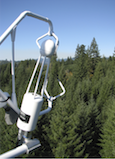New paper on turbulence in dense forests
21.10.2014
 We examined observations of the scale-dependent turbulent fluxes, variances, and the bulk transfer parameterization for sensible heat above, within, and beneath a tall closed Douglas-fir canopy in very weak winds. The...
We examined observations of the scale-dependent turbulent fluxes, variances, and the bulk transfer parameterization for sensible heat above, within, and beneath a tall closed Douglas-fir canopy in very weak winds. The...
... daytime sub-canopy vertical velocity spectra exhibit a double-peak structure with peaks at timescales of 0.8s and 51.2 s. A double-peak structure is also observed in the daytime sub-canopy heat flux co-spectra. The daytime momentum flux co-spectra in the upper bole space and in the sub-canopy are characterized by a relatively large cross-wind component, likely due to the extremely light and variable winds, such that the definition of a mean wind direction, and subsequent partitioning of the momentum flux into along- and cross-wind components, has little physical meaning. Positive values of both momentum flux components in the sub-canopy contribute to upward transfer of momentum, consistent with the observed sub-canopy secondary wind speed maximum. For the smallest resolved scales in the canopy at nighttime, we find increasing vertical velocity variance with decreasing timescale, consistent with very small eddies possibly generated by wake shedding from the canopy elements that transport momentum, but not heat. Unusually large values of the velocity aspect ratio within the canopy were observed, consistent with enhanced suppression of the horizontal wind components compared to the vertical by the very dense canopy. The flux–gradient approach for sensible heat flux is found to be valid for the sub-canopy and above-canopy layers when considered separately in spite of the very small fluxes on the order of a few W m−2 in the sub-canopy. However, single- source approaches that ignore the canopy fail because they make the heat flux appear to be counter-gradient when in fact it is aligned with the local temperature gradient in both the sub-canopy and above-canopy layers. While sub-canopy Stanton numbers agreed well with values typically reported in the literature, our estimates for the above-canopy Stanton number were much larger, which likely leads to underestimated modeled sensible heat fluxes above dark warm closed canopies.
The full citation is: Vickers D, Thomas CK. Observations of the scale-dependent turbulence and evaluation of the flux–gradient relationship for sensible heat for a closed Douglas-fir canopy in very weak wind conditions. Atmos Chem Phys. 2014;14(18):9665-9676. doi:10.5194/acp-14-9665-2014.
http://www.atmos-chem-phys.net/14/9665/2014/acp-14-9665-2014.html

